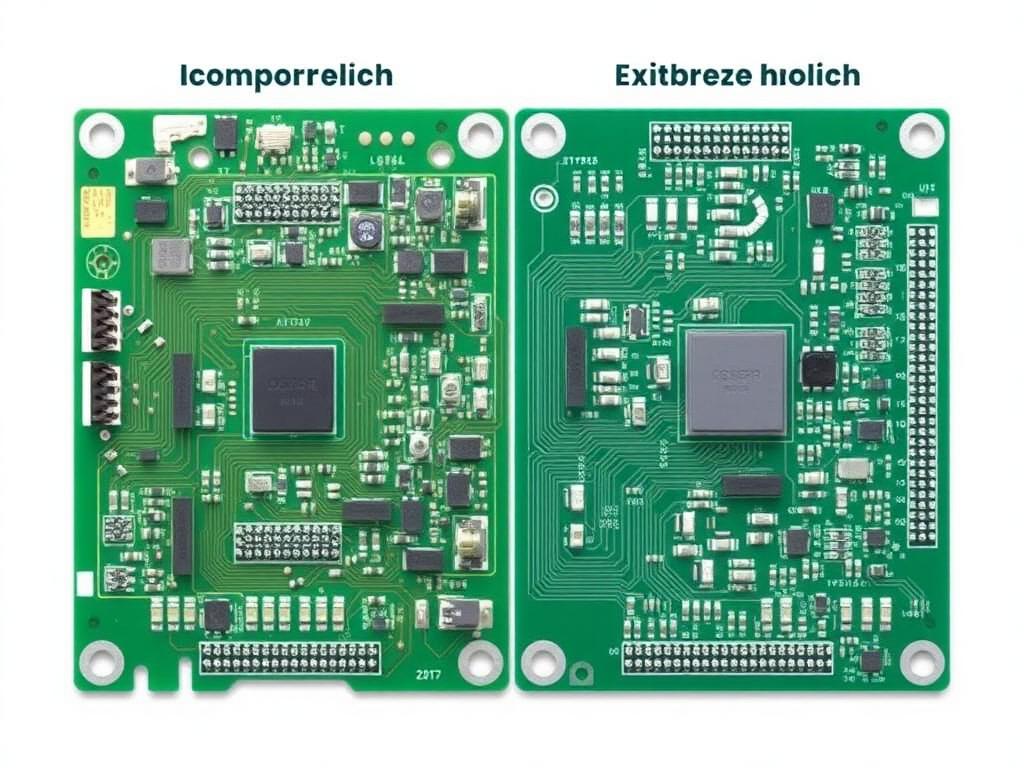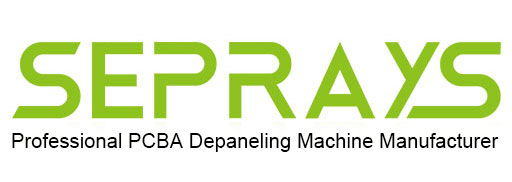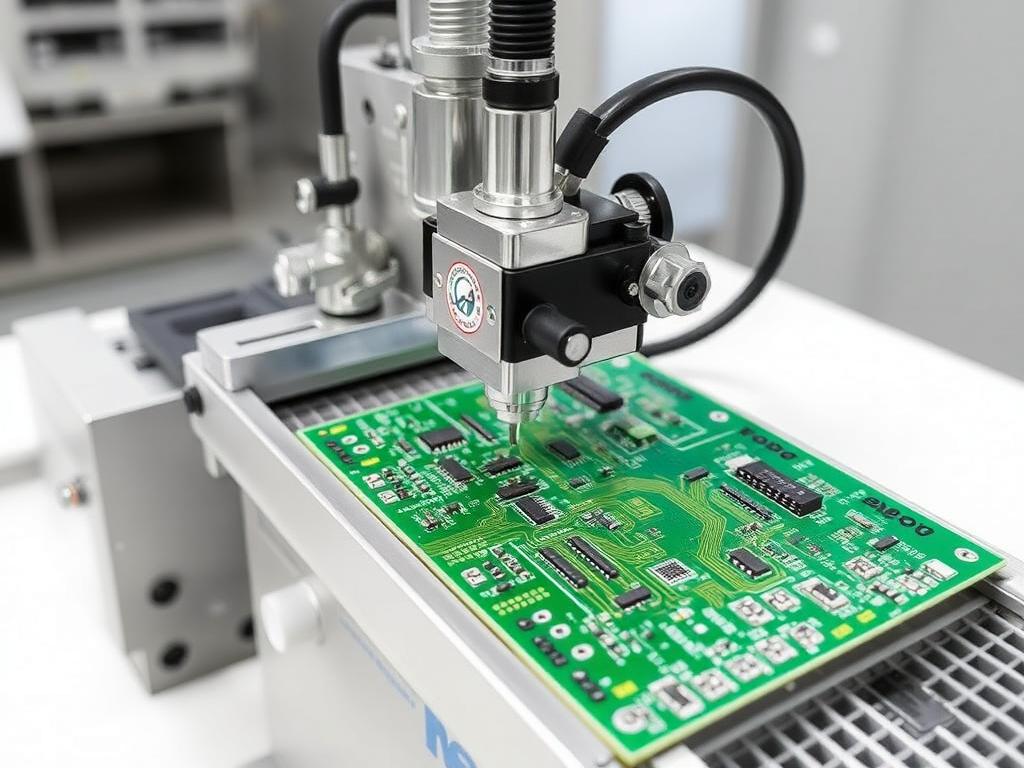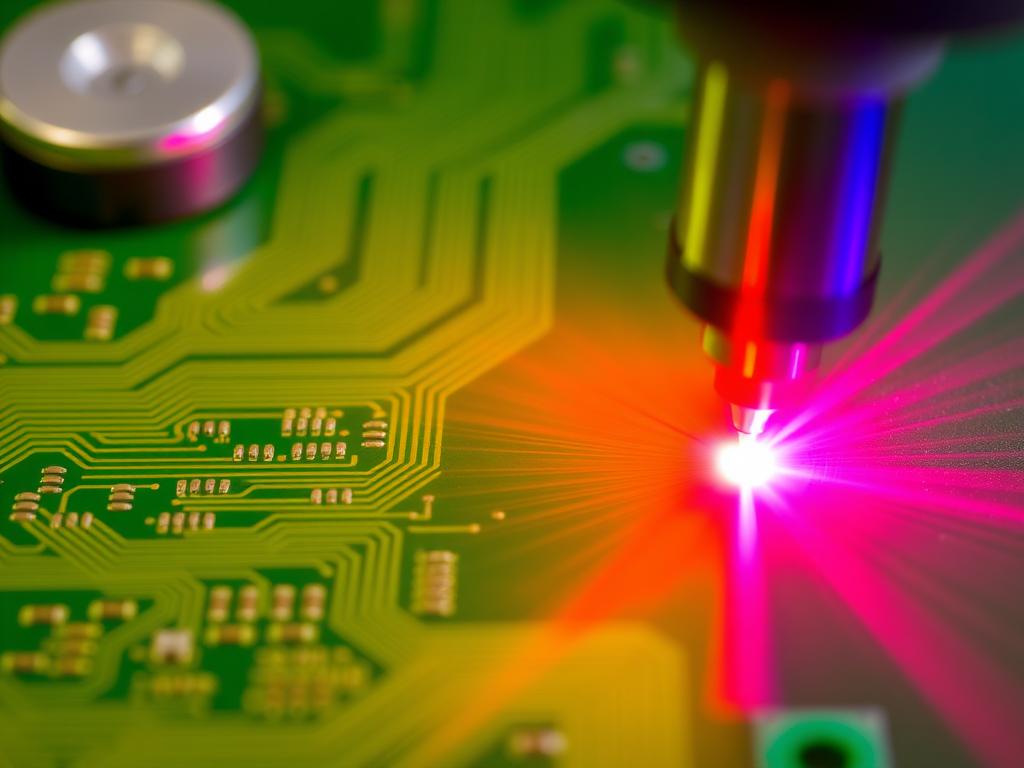![]()

Cost comparison of PCB depaneling methods
Precision PCB Depaneling: Choosing the Right Separation Method for Your Needs
As someone deeply involved in the PCB industry for over two decades, I’ve witnessed firsthand the evolution of การถอดแผง PCB. This crucial process, separating individual พีซีบี from a larger panel, significantly impacts the quality and reliability of finished electronic products. This article dives into the world of การแยก PCB, exploring various methods and helping you choose the best approach for your specific การผลิต PCB needs. Whether you are working in large factories or designing your own boards, understanding the intricacies of การถอดแผง PCB is very important for your success.
What exactly is pcb depaneling and why is it so important?
การ พีซีบี or printed circuit board, is the foundation of all modern electronic devices. During the การผลิต PCB process, multiple พีซีบี are often fabricated together on a larger panel, This technique of การกั้นแผง maximizes material usage and production efficiency. This panel then needs to be split into พีซีบีแบบรายบุคคล, a process we call การถอดแผง PCB หรือ การแยก PCB. The method we choose for การถอดแผงออก has a direct impact on the board itself. If we don’t choose wisely, it can result in issues like ความเครียดทางกล on the fragile components, which could lead to premature failure. This means that selecting the proper วิธีการแยก is not just a step in the กระบวนการผลิต, but a crucial decision affecting the overall quality and reliability of our final electronic product. It’s a critical step to ensure the พีซีบี function as intended, without any unseen damage caused during the กระบวนการถอดแผงออก.
จากประสบการณ์ของฉัน กระบวนการถอดแผงออก is often an afterthought, but it should not be. It’s where the potential for damage is the highest. Poor การถอดแผง PCB can mean not only compromised พีซีบี, but also higher repair costs, delays and unhappy clients. That is why it’s crucial to understand all the different วิธีการถอดแผงออก, and choose one that suits your specific type of พีซีบี and production volume. Whether we are working with a simple single-sided วงจรพิมพ์ or a complex multilayer board with sensitive components, it is important to always choose a ระบบถอดแผง that ensures minimal ความเครียดทางกล on our product.
What are the most commonly used depaneling methods, including v-scoring, routing, and laser?
Over the years, I have seen various วิธีการถอดแผงออก emerge. Each method has its pros and cons, suitable for different types of พีซีบี and production volumes. Some of the commonly used methods include การให้คะแนนแบบวี, การกำหนดเส้นทาง, การตัดด้วยเลเซอร์, and even old school methods like hand breaking. Let’s look at each one to understand what they are and how they perform. การให้คะแนนแบบ V, also known as ร่องวี, involves creating a pre-cut line along the board to weaken it and allow for clean separation. The การตัดแบบวี is done with special cutters. Routing, on the other hand, utilizes a บิตเราเตอร์, similar to a small โรงสี, to cut through the connecting material. This technique is often favored for its precision. Lastly, เลเซอร์ การถอดแผงออก uses a concentrated ลำแสงเลเซอร์ to vaporize the material separating the พีซีบี. Each method’s viability is directly tied to several factors, including the type of materials used in your พีซีบี, the complexity of the การออกแบบ PCB, and your production scale.
The selection of a suitable วิธีการแยก should not be taken lightly, especially for high-value พีซีบี. Each method provides different results, especially when it comes to ความเครียดทางกล, material usage, and cost. For example, การให้คะแนนแบบวี is usually more cost-effective, but not good for every พีซีบี. Router depaneling generates the least amount of stress at depaneling, especially when compared to traditional methods like hand breaking. Meanwhile, การถอดแผงด้วยเลเซอร์ provides unmatched precision but might carry a higher initial cost. The best method for you will depend on a number of factors, so it is critical to know them before making a decision. The right choice will be the one that gives you the least ความเครียดทางกล and the most cost-effective approach. This will depend on multiple factors, like your volume and your การออกแบบ PCB.
Why is a router, like a Sayaka pcb router, a good choice for certain projects?
From my personal experience, a เราเตอร์ is one of the most reliable methods of การแยก PCB, especially when dealing with complex board layouts. A เราเตอร์ uses a spinning บิตเราเตอร์ การตัดอย่างแม่นยำ PCB พร้อม the pre-determined path. This method offers a high degree of control and allows for very intricate shapes and tight tolerances, making it an ideal option for intricate การออกแบบ PCB. ก. router depaneling system ensures clean edges with minimal burrs or stress. One of the advantages of a เราเตอร์ method is that it’s good for different types of boards, including those with thicker traces or sensitive components. When it comes to different วิธีการแยก, router depaneling generates the least amount of stress on your board. This ensures a high yield and minimizes the risk of damaging your พีซีบี ในระหว่าง กระบวนการแยก.
Specifically, a Sayaka pcb router, known for its precision and reliability, is a common choice in many factories. While the initial investment might be higher than other options like การให้คะแนนแบบวี, the benefits of reduced ความเครียดทางกล, higher precision, and greater flexibility often justify the cost, especially in high-value applications. For those looking to improve the quality of the กระบวนการถอดแผงออก and reduce defects, a เราเตอร์ is a good starting point. It provides a balance between high precision and high throughput, making it a versatile choice for various การผลิต PCB environments. Whether you are separating single pcb หรือ multiple pcbs from a panel, a good quality เราเตอร์ will give you a professional and precise result.
When is laser pcb separation the best option?
ระบบถอดแผงด้วยเลเซอร์ represent the pinnacle of precision and flexibility in the การแยก PCB world. If you are dealing with extremely delicate boards, or those with fragile components, the เลเซอร์ is the way to go. It provides a non-contact method, using a focused ลำแสงเลเซอร์ to vaporize the material, การแยก PCB แต่ละชิ้น without applying any physical pressure. This is a huge advantage, as it means the การถอดแผงด้วยเลเซอร์ method produces the least amount of stress บน พีซีบี. This is especially useful when we are dealing with sensitive components that are easily damaged with methods that require physical contact.
การ price-performance ratio of laser depaneling is very high if your project is very precise. This allows very intricate cuts and shapes, something impossible with other methods. The main benefit of the เลเซอร์ method is the precision and ability to handle very complex and difficult designs. It is very useful in applications where high accuracy is critical. If you need a ไร้ฝุ่น environment, การถอดแผงด้วยเลเซอร์ is also a good option, as it is a very clean method, unlike for example เราเตอร์ methods, where dust is created. However, the initial cost of ระบบถอดแผงด้วยเลเซอร์ can be significantly higher than other methods, which makes it more suitable for high-value and low-volume applications, especially when very tight tolerances are needed.
How does v-scoring compare to other depaneling methods?
การให้คะแนนแบบ V, หรือ ร่องวี, is a popular method for การแยก PCB, particularly for แผงวงจรพิมพ์ with relatively simple shapes. It involves creating การตัดแบบวี grooves on both sides of the พีซีบี, using a special เครื่องตัด. This weakens the board, allowing for clean การแยกกัน when pressure is applied. While this method is very efficient for การผลิตปริมาณสูง, its capabilities are limited. It is best suited for การออกแบบ PCB with straight lines and does not offer the flexibility of a เราเตอร์ หรือ เลเซอร์.
The primary advantage of การให้คะแนนแบบวี เป็นของมัน ความคุ้มทุน, especially for simpler พีซีบี designs. The setup and tooling are more affordable than a เราเตอร์ หรือ ระบบถอดแผงด้วยเลเซอร์, making it suitable for projects with tight budgets. However, การให้คะแนนแบบวี is not suitable for every type of pcb. Bending the pcb ถึง แยก it may generate more ความเครียดทางกล than other methods. This makes it not ideal for complex boards with ส่วนประกอบที่ละเอียดอ่อน, where the slight bending can lead to damage. The วิธีการแยก itself is also less precise than others. While การให้คะแนนแบบวี can be good for some applications, it should never be the choice when precision and low ความเครียด is required.
Why is mechanical stress a crucial consideration in pcb design?
ความเครียดทางกล is a key factor that cannot be ignored in การออกแบบ PCB และ กระบวนการถอดแผงออก. When we put ความเครียดทางกล บน พีซีบี, it can lead to various problems, ranging from hairline fractures in the pcb board itself to damage of the components, and failure of solder joints. This is especially critical for modern พีซีบี which are usually very dense, with small, and fragile chip components. Methods like การหักมือ, which involve bending the pcb ถึง แยก it, are obviously the worst when it comes to applying ความเครียดทางกล. Minimizing ความเครียดทางกล ในระหว่าง กระบวนการถอดแผงออก is key to creating reliable แผงวงจรพิมพ์.
The amount of stress at การถอดแผงออก depends greatly on the method we choose. As I said earlier, methods like router depaneling generates the least, ในขณะที่ การให้คะแนนแบบวี, can add more stress, as we have to ทำลาย PCB ถึง แยก them. Designing a พีซีบี กับ tab routing helps reduce stress during การแยกกัน, ensuring that no extra force is applied to the board. Ultimately, if you want to have high quality พีซีบี, you will have to keep in mind the potential impact of ความเครียดทางกล in your การออกแบบ PCB. Always choose วิธีการถอดแผงออก that minimize the amount of ความเครียด your board will experience. It’s a critical factor that directly influences the long-term performance and reliability of your product.
What are the benefits of using a punch method for pcb separation?
การ ต่อย method is another approach to การแยก PCB. It uses a custom die and a hydraulic or pneumatic press to physically punch the พีซีบีแบบรายบุคคล out of a แผงขนาดใหญ่กว่า. This method is particularly effective for พีซีบี with simple and repetitive shapes and is well suited for การผลิตปริมาณสูง, where speed is of the essence. The ต่อย method is quick, and very efficient.
การ ต่อย method offers both advantages and disadvantages. It’s a very fast method, allowing for very high throughput. However, it requires custom dies, which can be expensive, especially for complex designs. The method is also not suitable for พีซีบี with intricate shapes. It is only good when dealing with uniform พีซีบี shapes, with no fragile components near the edges of the pcb. Also, we have to keep in mind that like any physical separation method, the ต่อย method may still generate ความเครียดทางกล. ระดับของ ความเครียดทางกล can be minimized by well-designed dies and a smooth action of the press, but it is still a factor that must be considered, especially for พีซีบี with sensitive components.
How does panelization influence the choice of separation method?
The way พีซีบี are arranged on a larger panel, called การกั้นแผง, greatly influences the choice of วิธีการแยก. Panelization เป็นขั้นตอนที่สำคัญมากในการ กระบวนการผลิต, where we have to decide how many พีซีบี we place on one panel, and how they will be connected with tabs. การ number of pcbs บน แผงขนาดใหญ่กว่า will determine what kind of ระบบถอดแผง we choose. If we are dealing with a complex layout, with many พีซีบีแบบรายบุคคล interconnected, we need a method that offers high precision and minimal ความเครียดทางกล, เช่น การกำหนดเส้นทาง หรือ เลเซอร์.
For simpler พีซีบี, การให้คะแนนแบบวี might be the better choice. It is important to remember that the connections between the พีซีบีแบบรายบุคคล have to be considered. The tabs or the small bridges that hold the พีซีบี together on the panel, have to be carefully designed. The right tab routing can minimize stress when you แยก them. The design of the panelization layout is not just a matter of convenience, but also a strategic choice that will impact the efficiency of the กระบวนการผลิต, and the final quality of our product.
What should be considered regarding initial investment and scalability?
When choosing a วิธีการถอดแผงออก, you should take into account both the initial investment และ scalability of the process. The initial investment in a ระบบถอดแผงด้วยเลเซอร์ is often significantly higher than การให้คะแนนแบบวี หรือ การกำหนดเส้นทาง. However, the long-term operational costs can be lower, especially in cases where you need higher precision and more flexibility. When thinking about the initial investment, you should also think about the cost of the equipment and tooling, and the cost of maintenance and operation.
ความสามารถในการปรับขนาด refers to how easily we can adjust our การถอดแผงออก process to meet changes in demand. If we expect an increase in production volume in the future, we need to choose a method that is easily scalable. Routing และ การถอดแผงด้วยเลเซอร์ systems are typically more scalable than การให้คะแนนแบบวี หรือ ต่อย methods, as they can handle different types of พีซีบี and production volumes. Always choose the most cost-effective option that meets your production requirements. Consider the long-term business goals of your company and pick a method that is not only cost effective now but also has enough scalability for future projects.
What are the latest advancements in technology and what to expect in the future?
ทุ่งแห่ง การถอดแผง PCB is continuously evolving, driven by advancements in technology and the growing complexity of electronic devices. One major advancement is the increasing use of ระบบอัตโนมัติ. Today, many ระบบถอดแผง, รวมทั้ง เราเตอร์, lasers, และ ต่อย machines, come with robotics and automated plate handling systems. This helps to increase efficiency and throughput while reducing the risk of human error. These ระบบอัตโนมัติ improvements also translate into cost savings and improve the consistency of the กระบวนการถอดแผงออก.
Another significant advancement is the development of more precise and efficient ระบบถอดแผงด้วยเลเซอร์. Newer เลเซอร์ systems are more energy-efficient and capable of handling a wider range of materials and thicknesses. These systems offer superior control and precision, leading to higher-quality cuts and less stress on the pcb board. The future of การถอดแผง PCB is about making the กระบวนการแยก more precise, more efficient, and more scalable. It will also include the improvement of methods that create the least amount of stress, like laser and เราเตอร์, as well as incorporating more automation and robotics.
Appendix – Comparing common methods in a table2.
Here’s a simplified table2 comparing the common วิธีการถอดแผงออก:
| วิธี | ค่าใช้จ่าย | ความแม่นยำ | ความเครียดเชิงกล | ความเร็ว | ความสามารถในการปรับขนาด | ดีที่สุดสำหรับ |
|---|---|---|---|---|---|---|
| การให้คะแนนแบบ V | ต่ำ | ปานกลาง | ปานกลาง | สูง | ต่ำ | Simple พีซีบี, high volumes |
| เราเตอร์ | ปานกลาง | สูง | ต่ำ | ปานกลาง | ปานกลาง | Complex designs, medium volumes, ส่วนประกอบที่ละเอียดอ่อน |
| เลเซอร์ | สูง | สูงมาก | Very Low | ปานกลาง | สูง | Intricate shapes, fragile chip components, high value |
| ต่อย | Medium to High | ต่ำ | ปานกลาง | สูงมาก | ต่ำ | Simple shapes, very high volumes |
FAQs:
เป็น router depaneling really the best for sensitive components? Yes, router depaneling is known for its low ความเครียดทางกล, making it a good choice for พีซีบี กับ fragile chip components. It offers a good balance of precision and stress reduction.
How much does a ระบบถอดแผงด้วยเลเซอร์ cost compared to other methods? ระบบถอดแผงด้วยเลเซอร์ typically have a higher initial investment เมื่อเทียบกับ การให้คะแนนแบบวี หรือ การกำหนดเส้นทาง due to the technology involved, but they offer better flexibility and precision.
สามารถ การให้คะแนนแบบวี damage my พีซีบี? การให้คะแนนแบบ V involves weakening the PCB พร้อม a line and then separating, which can sometimes cause minor damage if it is done without care. However, the amount of damage can be minimized if the การตัดแบบวี is properly done.
เป็น ระบบอัตโนมัติ worth the cost for การถอดแผง PCB? Yes, while the initial investment ใน ระบบอัตโนมัติ can be significant, it usually translates into long-term cost savings, increased efficiency, and more reliable results.
What is the most ไร้ความเครียด วิธีการแยก? การถอดแผงด้วยเลเซอร์ is generally considered the most ไร้ความเครียด method due to its non-contact nature, followed by เราเตอร์ วิธีการ
As someone who has seen all kinds of things in my time in the การผลิต PCB world, I know that choosing the right วิธีการถอดแผงออก is crucial for the success of your projects. I’ve worked with giants like TP-LINK, Canon, BYD, Flex, TCL, Xiaomi, Lenovo, OPPO, HONOR, and Foxconn, and I understand the specific requirements of การผลิตปริมาณสูง. Our products are known for their reliability and performance. If you’re looking for the best การถอดแผง PCB solutions, please don’t hesitate to ติดต่อเรา
ประเด็นสำคัญ:
- การถอดแผง PCB เป็นขั้นตอนที่สำคัญใน การผลิต PCB that directly impacts the quality and reliability of the final product.
- หลากหลาย วิธีการถอดแผงออก มีอยู่รวมทั้ง การให้คะแนนแบบวี, การกำหนดเส้นทาง, การตัดด้วยเลเซอร์, และ การต่อย,แต่ละอย่างก็มีข้อดีข้อเสียแตกต่างกันไป
- เอ เราเตอร์, like a Sayaka pcb router, is an excellent choice for high-precision needs, offering minimal stress, check here our router solutions.
- การถอดแผงด้วยเลเซอร์ offers unmatched precision and minimal ความเครียดทางกล, ideal for sensitive components and intricate shapes, here you can see our laser solutions.
- การให้คะแนนแบบ V is cost-effective for high-volume production of simple พีซีบี, take a look at our v-scoring machines.
- ความเครียดทางกล is a key consideration in การออกแบบ PCB and should be minimized during the กระบวนการถอดแผงออก.
- การเลือกของ วิธีการแยก is influenced by factors such as the complexity of the พีซีบี, การผลิต volume, and initial investment budgets.
- ระบบอัตโนมัติ และ advancements in technology are continuously improving the efficiency and precision of การถอดแผง PCB.
- Always choose a ระบบถอดแผง that ensures minimal ความเครียดทางกล on your product.
- We also offer a wide variety of อุปกรณ์อัตโนมัติ to streamline your production process
- We have high quality เครื่องประดับ for your machinery.
- For a complete solution, we also provide อุปกรณ์ SMT ทั้งสาย
Thank you very much for reading!




